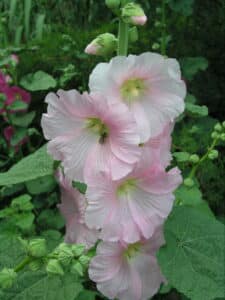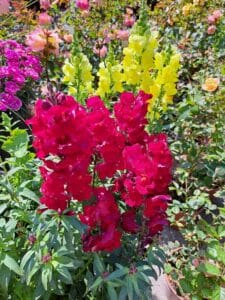June sees temperatures rising rapidly and plants will probably need some extra watering, which will keep you busy until at least the end of October. It goes without saying that you should water in the evenings or very early in the mornings, before the sun is up and use grey water when you can.
Try to keep the water off the leaves as they can be scorched at this time of year by the sun. It’s more important that the water reaches the root area of the plants, as that is where it is pumped up to the leaves and flowers.
Some years ago, I planted up a dry bank in my garden but the timing of it didn’t allow for the plants to settle in before temperatures rose. Neither did we have much in the way of rain! I managed to keep most of the plants going through the hot season by sinking a cut off plastic bottle, top down, behind each vulnerable plant which directed the water straight to the roots. I was very pleased when the rain came along during the winter and finished off the job for me.
This trick is also good for tomatoes. By sinking a plant pot with large holes in the bottom next to each plant and watering and feeding into that, the water goes straight to the roots. Irregular watering of tomatoes can lead to them to split, called ‘Blossom End Rot’.
WHAT TO DO IN THE GARDEN IN JUNE

Some plants you just can’t kill. Oenothera speciosa, a member of the evening primrose family, is one of those. hen grown en-masse it is stunning, but it can be very invasive and wander all over the garden! So, you have to control it severely, or it will take over. Bulbines or bulbinellas can grow equally as fast and are much enjoyed by bees and butterflies. These plants quickly become woody and send out root runners everywhere, so lovely as they are, they need strict control! Weeds growing around a watering point will grow quickly, so remove them before they seed themselves everywhere. Deadhead plants after rain, especially petunias, whose lovely flowers become very soggy if wet and can cause mould to form if they drop down on to the top of the soil. Pelargonium flower heads suffer from any rain and wind too, so trace the flower stems right back to where they grow from the main stem, where they will break off neatly. Sweep up any petals as they fall, especially the red ones, or they might stain your tiles and surrounds. The irritating thing is that there will still be some unopened buds underneath, which can be equally charming. The best thing to do is to remove the dying flowers from the top of the stem, so that lower flowers can also be enjoyed.
If you like tall spectacular plants then go for Echiums. Not the early spring Echium webbii with the tall blue flower heads, which have just finished flowering, but Echium wildpretti or Echium pininana, bi-annual plants growing to between 1 and 3 metres. The tiny flowers which are closely gathered around the massive flower stems can be white, pink or red. Or, how about Hollyhocks? These wonderful showy plants with single or double flowers are great for the back of border or to disguise an un-interesting wall. Hundreds of years ago, Alcea rosea, the common hollyhock, was imported into Europe from south-western China and at one time every cottage garden had them growing next to the front door. They are fully hardy and flower in the second year after sowing. These are short-lived perennials, available in both single and double flowers, so I advise when the stem gets to around 3-4 cm thick, it is time to dig them up, after collecting the seeds.
Hemerocallis and tulbaghia flowers are open fully now and add some glamour to the garden. Agapanthus, for some a tricky plant to get to flower, needs feeding after flowering and again in spring. Some say that in order to flower they need to be crowded together in a pot, and they can sulk for a year or two as well after being split up and re-potted. Choose a fertiliser with a low first number (nitrogen) or they will produce many leaves and few flowers. Although they come from very sunny countries, avoid growing them in full sun here, as the strap-like leaves may burn. As the outer leaves of irises begin to die off, remove them gently by pulling them away from the base of the plant. Then after a couple of weeks cut the remaining leaves into an inverted V shape, which will expose the rhizome to the sun, helping the plant prepare for next year’s flowers. Strew some bone meal around the base area or if you can’t get that, use a rose fertiliser and again in the early spring.
Pot plants can suffer greatly during these hot months, needing extra care and attention. Before you plant up your pots or baskets add some slow-release fertiliser to the soil, which will help the plants along. Long ago I used to advise adding in some water-retaining crystals to the mix, which would collect moisture and then release it later when the soil was dry. However, I haven’t seen any for sale in recent years. If you use terracotta pots then wet them too. They are porous and will soak up any water you give to the soil, thus depriving the plants, so keep them moist. I find that planting in a plastic pot and sitting that inside a terracotta or ceramic pot helps to protect the roots of the plants. It also means that if you need to repot the plants at any time, you can lift them out and not break your pretty and probably expensive outer pot.
Roses are looking good and are perfuming the evening air. However, they need regular deadheading to keep them blooming. Cut back the stem to an outward facing leaf bud and make a slanting cut just above it. Always wear strong gloves when you work among roses and protect your eyes, as some of them have very sharp thorns and can cause you serious injury. Other perfumed plants such as sweet peas are generally over by now as temperatures rise, unlike their northern European cousins that last all summer. Collect their seeds for next year, keeping them in a paper bag or envelope.
Annuals, those plants that grow from seed, flower, set seed and die all in one season, need dead heading regularly. You can collect seed from them now or let some of them fall to the ground where you will find that they will come up of their own accord next year, much earlier than those that you sow in the spring. Some of my favourite annuals are larkspur, most attractive in pinks, mauves and dark purples looking like dainty delphiniums, along with heavenly blue cerinthe, pretty petalled cosmos and nigella, with their feathery foliage and pastel-coloured flowers.
Canna lilies grow as well in pots as in the ground. They are such handsome plants if their paddle shaped leaves are not torn by summer winds or eaten by locusts or others insects, which find them very tasty. With many more varieties available here in a myriad of colours, I like ‘Durban’ best, with its very striated leaves and huge orange flowers, and I have grown this canna for a very long time here. Another favourite is ‘Lucifer’ which has bright red flowers edged with yellow, along with ‘Lenape’, which has a mottled flower. You probably won’t find them named in a garden centre, but you may be attracted to the leaves or flowers, so look up the names when you get them home.
Plant of the Month Antirrhinum majus

This popular summer flowering plant is sold as an annual here, but it is really classed as a short-lived perennial, meaning that it will only last for a couple of years or so in the garden. The common name ‘Snapdragon’ originated from the flowers’ reaction to having their throats squeezed, which causes the ‘mouth’ of the flower to snap open like a dragon’s mouth. By diving head-first into the opening mouth, bees use this way of pollinating the flowers. It is a great ornamental plant in borders and prefers to grow in well-drained soil in a sunny spot. Many have bright jewel-like colours with names like ‘Lemon Sherbet’, ‘Pretty in Pink’ or Black Prince, while others can be even bi-coloured and have fantastic names like ‘Lucky Lips’! Although not regarded as a florist’s flower, they can be picked and displayed in a vase indoors. This picking will encourage other flower stems to appear.
The pretty flowers are said to symbolise grace and strength. In past times snapdragons were used to ward off evil spirits and in traditional herbal medicine for treating several symptoms and diseases, including watery eyes, gum scurvy, haemorrhoids, ulcers, liver disorder, and tumours!







Click here to change your cookie preferences